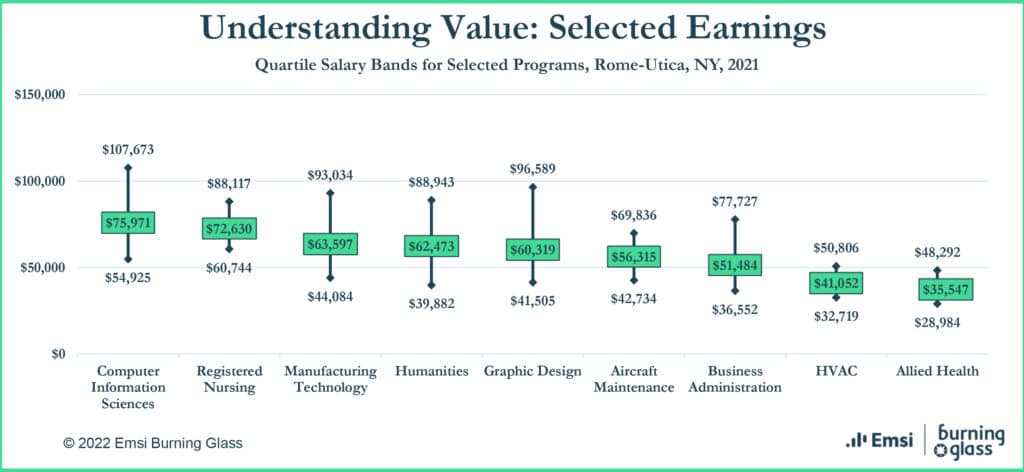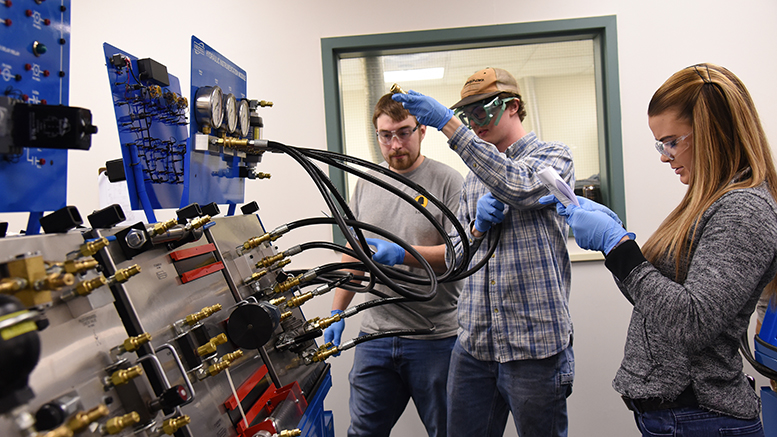In 2020, after more than 200 years, the Remington Arms factory in Ilion, New York, shut its doors, and nearly 250 mainly skilled labor employees without college degrees were let go. But fortunately, Mohawk Valley Community College (MVCC), located within 50 miles of the plant, stepped in to help retrain roughly 150 employees to begin work within in a newly opened Wolfspeed Inc. semiconductor chip manufacturing plant along with several other employers.
MVCC determined the appropriate fit to retrain many of the Remington employees was its eight-month mechatronics certificate program, preparing them for entry-level positions that involve the operation and maintenance of electro-mechanical systems commonly found in automated manufacturing environments. Other students were retrained in welding, CNC machining and HVAC, says Timothy Thomas, chief strategy officer and assistant vice president for learning and academic affairs at MVCC.
Editor’s note: This article is the first in a three-part series examining the use of labor market information (LMI) to promote community college agility. This story examines the rise of more powerful LMI analytics in recent years and how the use of LMI by Mohawk Valley Community College in New York enabled it to retrain factory employees for better jobs after a local plant closure.
On average, the retrained employees earned 20% more at Wolfspeed than they made at Remington Arms, an average of $22 per hour, a figure that has since risen to $28 and $30, Thomas says. The dislocated employees paid nothing as costs were picked up by federal Trade Adjustment Assistance Reauthorization Act of 2015 funding.
Thomas says that an important behind-the-scenes component of the success of this program was MVCC’s analysis of labor market information (LMI) regarding the needs of Wolfspeed and other employers.
“In this particular situation, we used labor market data analytics to have a better understanding of where the job openings were, and what skills and competencies were required, in order for somebody to get the first entry-level job within these companies,” says Thomas. “That allowed us to hone the curriculum to just what is needed to get these dislocated employees a job in the target companies, so that the retraining was not overbuilt.”
A crucial tool
LMI analysis, which includes sourcing, refining, combining and analyzing statistical data regarding past, existing and potential employers, employees and jobs, is an important tool that is enabling community colleges to become more agile in aligning educational programs to the world of work. It refines U.S. Census, other federal and state-sourced data, and industry data to help answer questions such as:
- Where students and prospective students seeking education, training and jobs reside
- Which employers in the community are offering what jobs
- What skills those jobs require
- How much employees in different jobs and with different skills will learn over time
- What their long-term educational and training needs are
While there are thus many applications of the LMI data, retraining of employees and rapidly tailoring short-term and stackable credential programs to quickly evolving career fields — an area of growth for community colleges in a time of enrollment challenges — is one area where the benefits of robust community college LMI capabilities really shine.
Use of LMI was, for example, a critical component of MVCC’s Fast Track career training program, which uses incremental credentials and on-the-job training to progressively educate students to start and continue progressing through more responsible positions. Thomas gives an example of retraining someone in a low-paid retail position to be a teacher through successively more advanced professional trainings and experiences, such as preparing through education teaching assistants in New York as a level one, then level two and then level three teaching assistant under New York law, with progressively better salary and benefits, and then steering those students towards an associate degree, and then, after transfer, to bachelor’s and finally masters degrees to enable them to become a fully credentialled teacher.
Better Insights
There is, on the one hand, confusing and dense data that raises more questions than it answers and, on the other hand, intelligible and meaningful data that is useful for helping community college leaders make decisions. Some data services providers assist community college clients to procure the latter by helping to source, refine and analyze LMI.
One is Lightcast, a data analytics consulting firm formed two years ago through the combination of predecessor companies Burning Glass Technologies and Emsi. Lightcast assists roughly 500 of the nation’s 1,300 community and technical colleges with LMI data, says Lightcast Vice President for Educational Success John Barnshaw, who estimates that another 200 of the 1,300 do significant LMI data analysis work either on their own or with the assistance of another data vendor.
A critical benefit of more powerful labor market information analytics is data visualization.
“That visualization makes the data more palatable for people who are not historic data people to operationalize data,” Thomas says. “So, I think that’s the most important thing that Lightcast has given us: the ability to visualize data well given that government databases just don’t do a good job of that.”
One example is a MVCC graph prepared by Lightcast that shows salary bands for different career fields in the Rome-Utica, New York, area in 2021 (see below). It generally shows a wide divergence of salaries on the low end of the band for a graduate of a two-year MVCC associate degree program versus, on the high end of the band, the salaries of graduates of a four-year program for various career fields.

The visual demonstrates the importance and potential for students and employees to earn more money over time with longer for-credit programs and transfer pathways in some fields given the large range in salaries for, as an example, computer information sciences employees (with a salary range between $54,925 and $107,673), as compared to those in careers with a narrower salary disparities, such as HVAC ($32,719 vs. $50,806), where employees will be hard-pressed to make more money, even with additional for-credit degrees and where the most appropriate educational offerings will likely be shorter-term, lower cost and often non-credit, certificates, credentials, boot camps and on-the-job training programs, notes Barnshaw.
He says Lightcast has increased its ability to isolate pinpoint data regarding different types of jobs and their component skills.
“In the past three years, labor market data analysis has grown much more granular and become much more useful,” Barnshaw says. “If you think about large occupational bucket codes, like SOC codes, they can be for ‘information technology’; and historically that has been about as granular as you could get. Whereas now, through an occupation taxonomy Lightcast has developed for more than 800 occupations, we can go two or three levels lower. So, we can get to not just ‘information technology,’ but ‘mobile web development,’ and then not just ‘mobile web development,’ we can get into iOS or Android-specific training and skills. So, you can imagine in a CTE world, or a continuing ed credit or non-credit education world, where people are looking for very narrow skills, this granularity is invaluable to figure out how to design programs to get students there.”
* * *
Part two of this series will examine how a robust LMI analytics capabilities are giving Dallas College (Texas) an edge in procuring and administering grants to serve the educational needs of disadvantaged members of its community.

